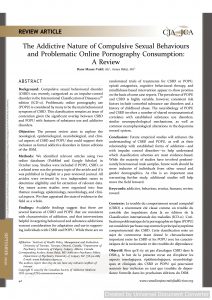Mental Health
The Addictive Nature of Compulsive Sexual Behaviours and Problematic Online Pornography Consumption
 Full Article Name: The Addictive Nature of Compulsive Sexual Behaviours and Problematic Online Pornography Consumption: A Review
Full Article Name: The Addictive Nature of Compulsive Sexual Behaviours and Problematic Online Pornography Consumption: A Review
Open Access: No
Abstract
Background: Compulsive sexual behavioural disorder (CSBD) was recently categorized as an impulse-control disorder in the International Classification of Diseases 11th edition (ICD-11). Problematic online pornography use (POPU) is considered by many to be the main behavioural symptom of CSBD. This classification remains an issue of contention given the significant overlap between CSBD and POPU with features of substance use and addictive disorders. Objective: The present review aims to explore the nosological, epidemiological, neurobiological, and clinical aspects of CSBD and POPU that could support their inclusion as formal addictive disorders in future editions of the DSM. Methods: We identified relevant articles using two online databases (PubMed and Google Scholar) in October 2019. Studies were included if POPU, CSBD, or a related term was the primary topic of the article and if it was published in English in a peer-reviewed journal. All articles were reviewed by two independent raters to determine eligibility and for extraction of relevant data. Key issues across studies were organized into four themes: nosology, epidemiology, neurobiology, and clinical aspects. We then appraised the state of evidence in the field as a whole. Findings: Available findings suggest that there are several features of CSBD and POPU that are consistent with characteristics of addiction, and that interventions helpful in targeting behavioural and substance addictions warrant consideration for adaptation and use in supporting individuals with CSBD and POPU. While there are no randomized trials of treatments for CSBD or POPU, opioid antagonists, cognitive behavioural therapy, and mindfulness-based intervention appear to show promise on the basis of some case reports. The prevalence of POPU and CSBD is highly variable, however, consistent risk factors include comorbid substance use disorders and a history of childhood abuse. The neurobiology of POPU and CSBD involves a number of shared neuroanatomical correlates with established substance use disorders, similar neuropsychological mechanisms, as well as common neurophysiological alterations in the dopamine reward system. Conclusion: Future empirical studies will enhance the understanding of CSBD and POPU, as well as their relationship with established forms of addiction—and with impulse control disorders—to help understand which classification schemes are most evidence-based. While the majority of studies have involved predominantly heterosexual male samples, future work should be more inclusive of individuals from other sexual and gender demographics. As this is an important area warranting further study, additional studies will help move the field forward.
Citation
Mauer-Vakil, D., & Bahji, A. (2020). The addictive nature of compulsive sexual behaviours and problematic online pornography consumption: a review. Canadian Journal of Addiction, 11(3), 42–51. https://doi.org/10.1097/CXA.0000000000000091

